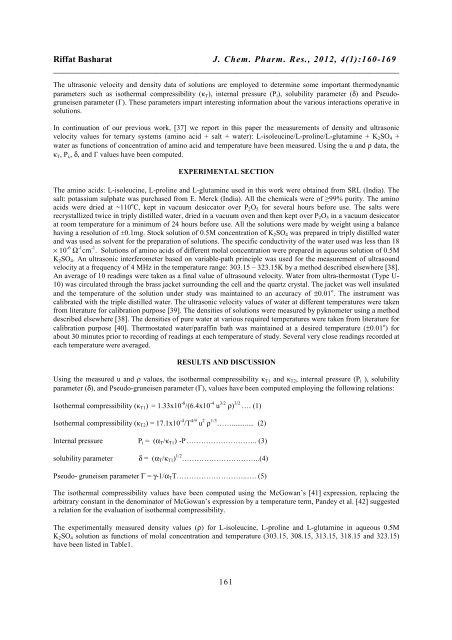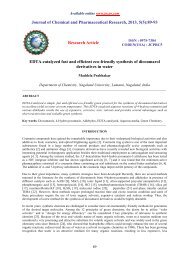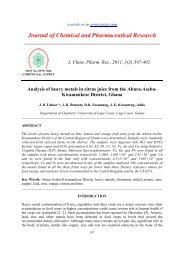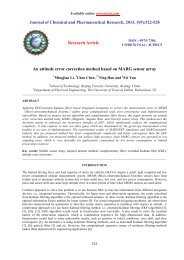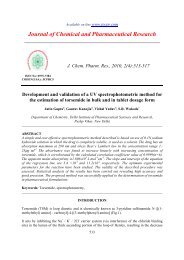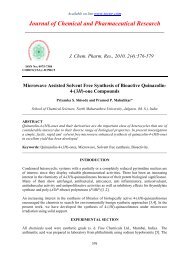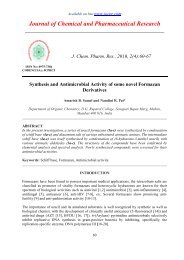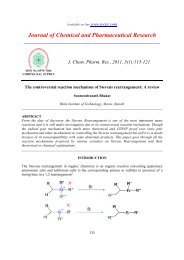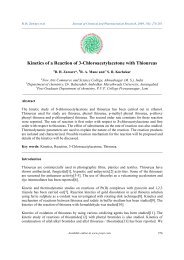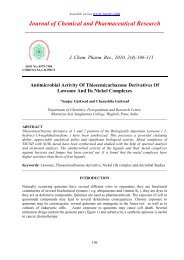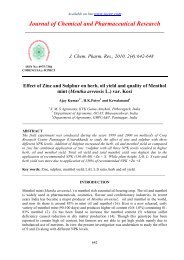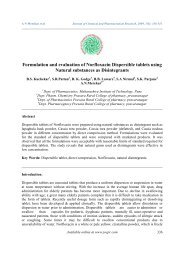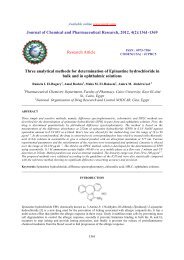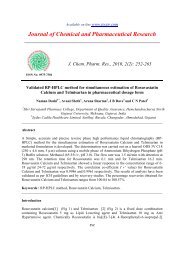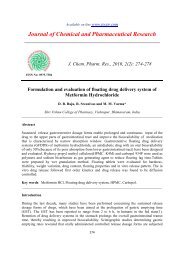Research Article - Journal of Chemical and Pharmaceutical Research
Research Article - Journal of Chemical and Pharmaceutical Research
Research Article - Journal of Chemical and Pharmaceutical Research
You also want an ePaper? Increase the reach of your titles
YUMPU automatically turns print PDFs into web optimized ePapers that Google loves.
Riffat Basharat J. Chem. Pharm. Res., 2012, 4(1):160-169<br />
______________________________________________________________________________<br />
The ultrasonic velocity <strong>and</strong> density data <strong>of</strong> solutions are employed to determine some important thermodynamic<br />
parameters such as isothermal compressibility (κ T ), internal pressure (P i ), solubility parameter (δ) <strong>and</strong> Pseudogruneisen<br />
parameter (Γ). These parameters impart interesting information about the various interactions operative in<br />
solutions.<br />
In continuation <strong>of</strong> our previous work, [37] we report in this paper the measurements <strong>of</strong> density <strong>and</strong> ultrasonic<br />
velocity values for ternary systems (amino acid + salt + water): L-isoleucine/L-proline/L-glutamine + K 2 SO 4 +<br />
water as functions <strong>of</strong> concentration <strong>of</strong> amino acid <strong>and</strong> temperature have been measured. Using the u <strong>and</strong> ρ data, the<br />
κ T , P i, , δ, <strong>and</strong> Γ values have been computed.<br />
EXPERIMENTAL SECTION<br />
The amino acids: L-isoleucine, L-proline <strong>and</strong> L-glutamine used in this work were obtained from SRL (India). The<br />
salt: potassium sulphate was purchased from E. Merck (India). All the chemicals were <strong>of</strong> ≥99% purity. The amino<br />
acids were dried at ~110 o C, kept in vacuum desiccator over P 2 O 5 for several hours before use. The salts were<br />
recrystallized twice in triply distilled water, dried in a vacuum oven <strong>and</strong> then kept over P 2 O 5 in a vacuum desiccator<br />
at room temperature for a minimum <strong>of</strong> 24 hours before use. All the solutions were made by weight using a balance<br />
having a resolution <strong>of</strong> ±0.1mg. Stock solution <strong>of</strong> 0.5M concentration <strong>of</strong> K 2 SO 4 was prepared in triply distilled water<br />
<strong>and</strong> was used as solvent for the preparation <strong>of</strong> solutions. The specific conductivity <strong>of</strong> the water used was less than 18<br />
× 10 -6 Ω -1 cm -1 . Solutions <strong>of</strong> amino acids <strong>of</strong> different molal concentration were prepared in aqueous solution <strong>of</strong> 0.5M<br />
K 2 SO 4 . An ultrasonic interferometer based on variable-path principle was used for the measurement <strong>of</strong> ultrasound<br />
velocity at a frequency <strong>of</strong> 4 MHz in the temperature range: 303.15 – 323.15K by a method described elsewhere [38].<br />
An average <strong>of</strong> 10 readings were taken as a final value <strong>of</strong> ultrasound velocity. Water from ultra-thermostat (Type U-<br />
10) was circulated through the brass jacket surrounding the cell <strong>and</strong> the quartz crystal. The jacket was well insulated<br />
<strong>and</strong> the temperature <strong>of</strong> the solution under study was maintained to an accuracy <strong>of</strong> ±0.01 o . The instrument was<br />
calibrated with the triple distilled water. The ultrasonic velocity values <strong>of</strong> water at different temperatures were taken<br />
from literature for calibration purpose [39]. The densities <strong>of</strong> solutions were measured by pyknometer using a method<br />
described elsewhere [38]. The densities <strong>of</strong> pure water at various required temperatures were taken from literature for<br />
calibration purpose [40]. Thermostated water/paraffin bath was maintained at a desired temperature (±0.01 o ) for<br />
about 30 minutes prior to recording <strong>of</strong> readings at each temperature <strong>of</strong> study. Several very close readings recorded at<br />
each temperature were averaged.<br />
RESULTS AND DISCUSSION<br />
Using the measured u <strong>and</strong> ρ values, the isothermal compressibility κ T1 <strong>and</strong> κ T2 , internal pressure (P i ), solubility<br />
parameter (δ), <strong>and</strong> Pseudo-gruneisen parameter (Γ), values have been computed employing the following relations:<br />
Isothermal compressibility (κ T1 ) = 1.33x10 -8 /(6.4x10 -4 u 3/2 ρ) 3/2 …. (1)<br />
Isothermal compressibility (κ T2 ) = 17.1x10 -4 /T 4/9 u 2 ρ 1/3 ……............ (2)<br />
Internal pressure P i = (α T /κ T1 ) -P ……………………….. (3)<br />
solubility parameter<br />
δ = (α T /κ T1 ) 1/2 …………………………..(4)<br />
Pseudo- gruneisen parameter Γ = γ-1/α T T………………………..…. (5)<br />
The isothermal compressibility values have been computed using the McGowan’s [41] expression, replacing the<br />
arbitrary constant in the denominator <strong>of</strong> McGowan’s expression by a temperature term, P<strong>and</strong>ey et al. [42] suggested<br />
a relation for the evaluation <strong>of</strong> isothermal compressibility.<br />
The experimentally measured density values (ρ) for L-isoleucine, L-proline <strong>and</strong> L-glutamine in aqueous 0.5M<br />
K 2 SO 4 solution as functions <strong>of</strong> molal concentration <strong>and</strong> temperature (303.15, 308.15, 313.15, 318.15 <strong>and</strong> 323.15)<br />
have been listed in Table1.<br />
161


